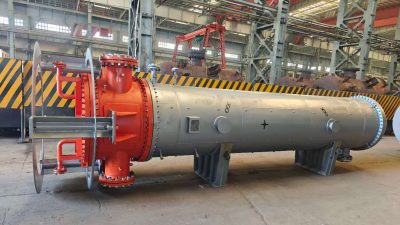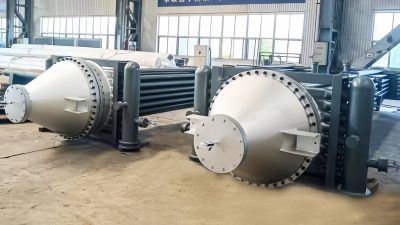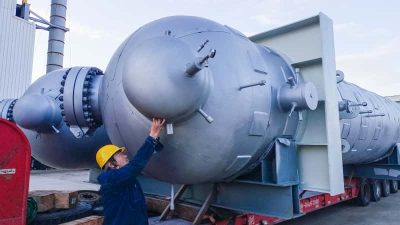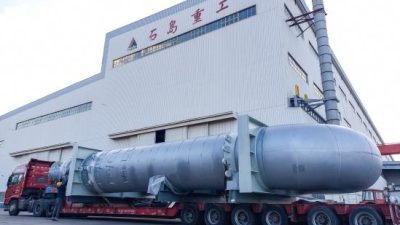Send Email
Call / WhatsApp Anytime
Send Email
Call / WhatsApp Anytime
A Shell and Tube Heat Exchanger is the most widely used type of heat exchanger in industrial applications. It consists of a series of tubes (the tube bundle) housed inside a cylindrical shell, allowing two fluids to exchange heat—one flowing inside the tubes (tube side) and the other flowing outside the tubes within the shell (shell side)—without mixing.
Weihai Shidao Heavy Industry Co., Ltd. is a leading Chinese manufacturer of high-performance Shell and Tube Heat Exchangers engineered for demanding industrial environments. With over two decades of experience and full certifications including ASME U Stamp, PED, and ISO 9001, Weihai Shidao designs and fabricates custom exchangers tailored to critical applications in oil & gas, petrochemical, chemical processing, and power generation industries.




| Classification Dimension | Category | Description |
|---|---|---|
| By Construction Type | – Fixed Tube Sheet- U-Tube- Floating Head- Expansion Joint– Breech Lock Type | Breech Lock is an advanced high-pressure structure using a bayonet-style closure. It enables tool-free quick access to the tube bundle without unbolting. |
| By Shell Configuration | – Single-Pass Shell- Multi-Pass Shell- Split-Flow Shell | Flow configurations affect heat transfer efficiency and pressure drop. |
| By Tube Layout | – Triangular Pitch- Square Pitch- Rotated Square Pitch | Determines turbulence, heat transfer rate, and cleaning ease. |
| By Flow Arrangement | – Counterflow- Parallel Flow- Crossflow | Counterflow offers maximum temperature efficiency. |
| By Functional Use | – Condenser- Reboiler- Cooler- Heater- Evaporator | Classification based on application within process systems. |
| By Design Standards | – TEMA Types (e.g., AES, BEM, BEU)- ASME Sec.VIII- GB150- PED | Determines design rules, material specs, testing, and certification compliance. |
| By Material | – Carbon Steel- Stainless Steel- Duplex Steel- Titanium- Copper Alloy | Selected based on corrosion resistance, temperature/pressure rating, and fluid compatibility. |
| By Maintenance Access | – Non-removable Tube Bundle- Removable Tube Bundle– Quick-Opening Type (e.g., Breech Lock) | Breech Lock offers safe and rapid maintenance without full disassembly—ideal for high-risk, high-frequency inspection environments. |
| By Heat Transfer Type | – Liquid-to-Liquid- Gas-to-Liquid- Condensation- Boiling | Based on fluid phase and heat exchange purpose. |
Certified Safety, Reliable Quality, Custom-Engineered Pressure Vessels.
— Globally Compliant, Built for Harsh Industrial Conditions.
Shell and tube heat exchangers are the most commonly used type of heat transfer equipment in industrial process systems. With their modular design, high thermal efficiency, and ability to withstand extreme operating conditions, they are essential across a wide range of industries. Weihai Shidao’s shell and tube heat exchangers are engineered to meet the most rigorous demands, offering customized configurations, international standard compliance, and long-term durability.
Oil & Gas Industry
Widely used in amine gas treating, gas dehydration, and NGL recovery systems. Ideal for high-pressure, sour service conditions with demanding thermal loads. Weihai Shidao exchangers provide stable performance and ease of maintenance in offshore platforms, refineries, and gas processing plants.
Petrochemical Industry
Applied in hydrogen reformers, olefin production, aromatics extraction, and syngas cooling. Designed for high-temperature, cyclic thermal duty, the exchangers support continuous operation in cracking and synthesis processes with reliable sealing and thermal efficiency.
Refining Industry
Utilized in hydrocracking, catalytic reforming, crude preheat trains, and vacuum column overhead condensers. Engineered for extreme pressure and temperature, the exchangers are built to withstand heavy fouling and thermal cycling in continuous refinery service.
Chemical & Fertilizer Plants
Used in urea, ammonia, nitric acid, and methanol production lines. Resistant to corrosive and high-pressure synthesis loops, Weihai Shidao exchangers are ideal for carbamate condensers, high-pressure interchangers, and scrubber systems.
Power Generation
Deployed in feedwater heaters, boiler economizers, steam coolers, and condensate recovery. Designed for scale resistance and thermal cycling, these exchangers ensure long-term stability in high-temperature water-steam circuits of thermal and combined-cycle power plants.
Industrial Utilities & Heat Recovery
Integrated into waste heat recovery, cooling water systems, and energy efficiency upgrades. Flexible in design and material, Weihai Shidao units help improve thermal performance and reduce operational costs in plant utility systems.
With decades of engineering experience and global project delivery, Weihai Shidao provides shell and tube heat exchangers tailored to each industry’s specific needs. Whether used in high-pressure hydrogen loops, corrosive chemical reactors, or thermal energy recovery systems, our exchangers are designed for long-term reliability, safe operation, and maximum process efficiency.
A shell and tube heat exchanger is a type of heat transfer equipment that consists of a bundle of tubes inside a cylindrical shell. One fluid flows through the tubes (tube side), while another flows around the tubes within the shell (shell side), allowing heat to be exchanged between the two fluids without mixing them.
A shell and tube heat exchanger works by transferring heat between two fluids—one flowing inside the tubes (tube side) and one flowing outside the tubes, within the shell (shell side)—without mixing them. Heat flows through the walls of the tubes, from the hot fluid to the cold fluid, using conduction and convection.
| Component | Function |
|---|---|
| Tubes | Carry one of the fluids (usually the cleaner or higher-pressure one) |
| Shell | Encases the tube bundle and carries the second fluid |
| Tube Sheets | Hold the tubes in position and seal them from the shell-side fluid |
| Baffles | Guide the shell-side fluid back and forth across the tubes to enhance heat transfer |
| Channel Head | Contains the tube-side inlet and outlet connections |
| Nozzles | Inlet and outlet ports for both fluids |
| Step | Description |
|---|---|
| 1 | The hot fluid enters either the tube side or shell side, depending on process needs |
| 2 | The cold fluid enters the opposite side (tube or shell) |
| 3 | Heat transfers from the hotter fluid through the tube wall to the colder fluid |
| 4 | The fluids exit the exchanger at their new temperatures, without mixing |
| Flow Configuration | Description |
|---|---|
| Counter-flow | Fluids move in opposite directions for maximum temperature gradient |
| Parallel-flow | Both fluids move in the same direction (less efficient) |
| Cross-flow | Fluids move perpendicularly (less common in S&T designs) |
| Multi-pass | One fluid passes through multiple passes to increase heat transfer |
| Industry | Application | Tube Side Fluid | Shell Side Fluid |
|---|---|---|---|
| Refining | Crude preheater | Crude oil | Hot process gas |
| Chemical | Urea condenser | Process vapor | Cooling water |
| Power generation | Feedwater heater | Boiler feedwater | Condensate steam |
The typical design pressure and temperature range of a shell and tube heat exchanger depends on the materials used, construction design (e.g., TEMA or ASME code), and the application’s process requirements. However, general industrial standards can be summarized as follows:
| Parameter | Typical Range |
|---|---|
| Design Pressure | 10 bar to 100 bar (145 – 1,450 psi) |
| Design Temperature | -100°C to 600°C (-148°F to 1112°F) |
| Application | Pressure | Temperature | Notes |
|---|---|---|---|
| Boiler feedwater heater | ~50–100 bar | 200–350°C | Power plants |
| Ammonia synthesis loop cooler | ~150–300 bar | 250–400°C | Fertilizer plants |
| Crude oil preheater | ~10–40 bar | 150–350°C | Refining and petrochemical |
| Hydrogen reformer effluent cooler | ~80–120 bar | 400–600°C | High-temp/high-pressure gas cooling |
| Chilled water cooler | <10 bar | 5–80°C | HVAC, utility cooling |
If you’re designing for a specific project and need help determining the appropriate range or code compliance, I can assist with that too. Would you like this as a downloadable design guide or in Chinese?
| Classification | Types / Options |
|---|---|
| Tube Bundle Type | Fixed Tube Sheet, U-Tube, Floating Head |
| Flow Configuration | Single-Pass, Multi-Pass, Counterflow, Parallel Flow |
| TEMA Mechanical Design | BEM, AES, AET, BEU, etc. |
| Mounting Orientation | Horizontal, Vertical |
| Functional Application | Condenser, Reboiler, Heater, Cooler, Feed-Effluent Exchanger |
The price of a shell and tube heat exchanger varies significantly based on factors such as size, material, pressure/temperature ratings, design complexity, and compliance with industry codes. Since these units are often custom-engineered, pricing is typically provided on a case-by-case basis (RFQ).
| Capacity / Size | Estimated Price Range (USD) |
|---|---|
| Small (5–10 m² heat transfer area) | $2,000 – $8,000 |
| Medium (20–50 m²) | $10,000 – $30,000 |
| Large industrial (100–500+ m²) | $40,000 – $150,000+ |
| High-pressure or exotic material unit | $100,000 – $500,000+ |
⚠️ Note: These are budgetary estimates only. Final pricing depends heavily on technical specifications and compliance requirements.
Heat Transfer Area – Larger surface areas require more tubes, longer shells, and larger frames, which increases cost.
Material Selection – Carbon steel is relatively inexpensive; stainless steel, duplex, titanium, Inconel, and Hastelloy significantly increase cost.
Design Pressure and Temperature – Higher ratings require thicker walls, stronger supports, and stricter testing, all of which add to the price.
Mechanical Design Type – Floating head or U-tube designs are more complex and costly than fixed tube sheet types.
Code & Certification Requirements – ASME U Stamp, PED, TEMA Class R, or third-party inspection adds to fabrication and documentation costs.
Testing Requirements – Radiography (RT), ultrasonic (UT), helium leak test, PMI, and hydrostatic testing increase QA/QC costs.
Delivery & Logistics – Export packaging, international transport, and on-site installation support affect total project cost.
Optional Add-ons – Skid mounting, insulation, automatic cleaning systems, and instrumentation further impact pricing.
| Application | Size | Material | Estimated Price (USD) |
|---|---|---|---|
| Water cooler for HVAC | 10 m² | SS304 | $3,000 – $6,000 |
| Urea plant carbamate condenser | 80 m² | SS316L + Titanium | $60,000 – $120,000 |
| Refinery feed/effluent unit | 200 m² | Carbon Steel | $50,000 – $90,000 |
| Hydrogen reformer exchanger | 150 m² | Inconel-clad | $150,000 – $300,000 |
Inlet/outlet temperature and pressure of both fluids
Flow rates or heat duty (kW or kcal/h)
Fluid types (tube side and shell side)
Preferred material and design standard (ASME, TEMA, PED)
Required surface area or overall size
Mounting orientation and operating environment
Would you like an RFQ template or help preparing a technical inquiry form for Weihai Shidao?
Ready to optimize your thermal systems with industry-proven heat exchange solutions?
Contact WSHI today to discuss your application needs. Whether you’re operating in petrochemical, power generation, chemical processing, or next-gen energy sectors, our engineering team will deliver tailored heat exchanger systems built for performance, reliability, and efficiency.
📩 Get in touch now for technical consultation, custom design support, or a detailed quotation.
Let’s engineer the future of energy efficiency—together.